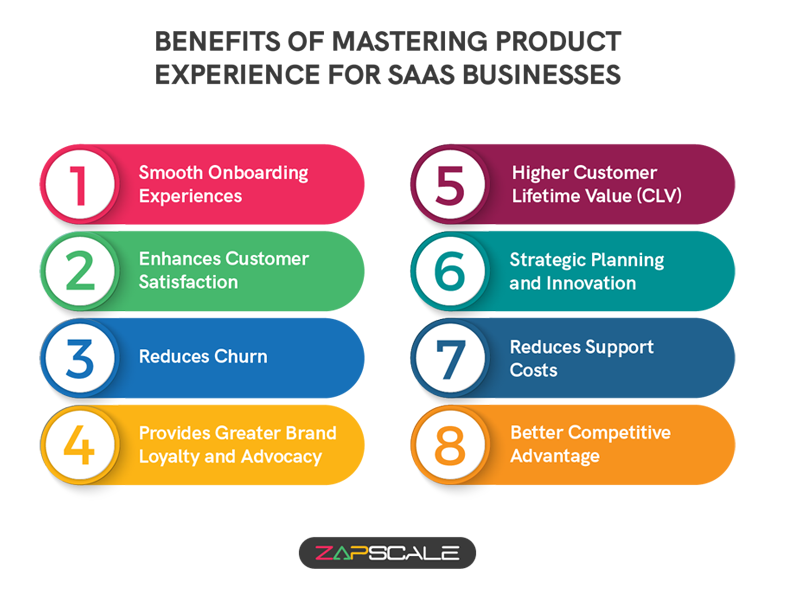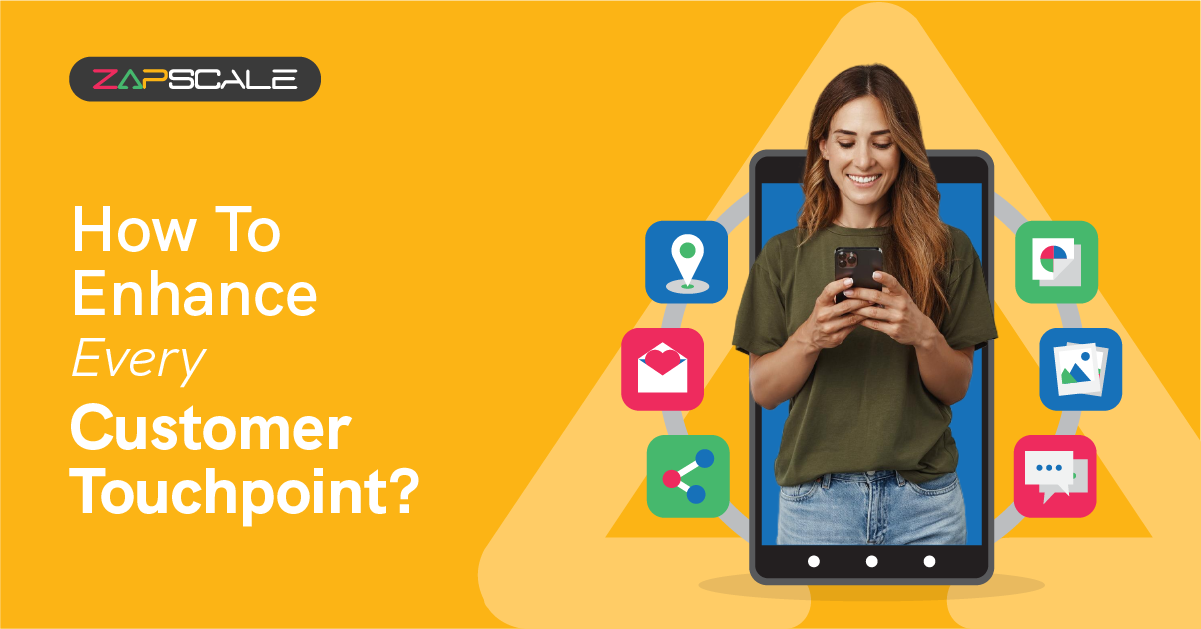CATEGORY > Customer Experience
A Practical Guide to Mastering Product Experience

Product experience is important in determining how products achieve economic success in today's digital landscape.
Let’s explore this concept in more detail by reading below.
What Is Product Experience?
To explain product experience in a single line, it describes how a particular product or offering makes you feel after using it.
To describe product experience formally, it includes users' feelings, perceptions, and interactions with a product, which is critical for SaaS and digital transformations.
Unlike user experience, product experience considers the complete path within an application, from onboarding to value realization.
Product experience is critical for coordinating digital products with business objectives.
Improving product experience enhances revenue and customer retention.
Creating engaging digital experiences is critical for updating and boosting customer satisfaction and loyalty.
What Does "Product Experience Management" Mean?
Product experience management refers to the strategy, processes, and tools you implement to ensure that your product information and media are configured to provide your customers with the desired experience on their preferred channel.
Product experience management maintains all aspects of your product experience, including customer data and product information.
It employs AI to tailor what every customer sees across several channels (website, app, etc.).
But why does it do so?
Simply, to give users what they need, when they need it, so they can make a purchase conveniently.
Most businesses utilize data to monitor how well product experience management is performing and make changes accordingly to keep customers satisfied.
To throw some more light on product experience management, it’s important to highlight how it improves customer interactions by centralizing and enriching product data across all channels.
Product experience management utilizes artificial intelligence and machine learning to connect transaction and interaction data so that users can make the most of personalized and contextually appropriate content.
With product experience management, you can ensure constant, high-quality product information, which improves customer decision-making and increases conversions in omnichannel contexts.
Many e-commerce businesses improve and modify their product channels by analyzing customer feedback and behavior, resulting in increased overall customer satisfaction and loyalty.
Product Experience V/s User Experience
Product experience and user experience are two sides of the same coin.
Product Experience refers to the total emotional response that people feel when using a product, which is molded by each encounter from beginning to end.
User experience is one part or subset of product experience which refers to how customers interact with a product's major features and how easy it is for them to complete tasks.
Here are some common differences between these two concepts to help you get a better understanding.
1. Focus
a. Product Experience
Encompasses the complete journey and emotional response of users as they interact with a product.
b. User Experience
Specifically focuses on how people engage with the product's core capabilities. Its goal is to improve usability, efficiency, and task satisfaction.
2. Metrics
a. Product Experience
Evaluate customer satisfaction surveys, user sentiment, brand impression, and net promoter score (NPS).
These gauge overall feelings towards the product.
b. User Experience
Concentrates on usability measures such as job completion rates, time on task, mistake rates, and user clickstream data.
These assess efficiency and simplicity of usage.
3. Personalization
a. Product Experience
Attempts to personalize the user experience based on individual requirements and preferences.
Loyalty schemes, personalized marketing messaging, and specialized customer care encounters all help to personalize.
b. User Experience
While certain customization or adaptable features may be accessible, the primary purpose is to guarantee that the product is usable and useful for a wide range of consumers.
4. Required Expertise
a. Product Experience
Requires a better understanding of marketing, branding, customer service, and user research to create a seamless experience.
b. User Experience
Focuses on usability concepts, information architecture, and interaction design to guarantee smooth user interactions.
Why Is Product Experience Important?
An excellent product experience enables you to quickly achieve goals, feel satisfied and confident, remain engaged, comprehend value, provide feedback, suggest the product, adapt and evolve with user demands, receive dependable support, and feel a part of a supportive community.
Let’s learn a bit more about what makes product experience crucial for modern businesses.

1. Smooth Onboarding Experiences
Product experience matters from the very first click.
Automated walkthroughs and individualized in-app instructions improve the product experience for new users, reducing churn and increasing satisfaction.
Segmenting customer journeys and using retroactive product data improves product experience by maximizing feature adoption and usability.

2. Enhanced Customer Satisfaction
PX promotes addressing user needs throughout all interactions.
A seamless, engaging experience increases satisfaction, establishing strong customer relationships based on trust and reliability.
Consistently providing pleasant experiences ensures that users feel appreciated and promotes long-term loyalty to the product and brand.
3. Reduced Churn
A bad product experience frequently results in higher churn rates as unsatisfied users seek alternatives.
Investing in product experience projects increases long-term customer satisfaction by resolving pain points and improving usability.
This proactive approach not only keeps customers but also strengthens brand loyalty, lowering the risk that users would migrate to competitors.
4. Greater Brand Loyalty And Advocacy
A great experience increases loyalty by encouraging consumers to promote your product through word-of-mouth and online reviews.
When users feel valued and their needs are addressed, they are more likely to become loyal customers and even brand evangelists.
5. Higher Customer Lifetime Value
Investing in product experience promotes long-term relationships with customers, which increases CLV.
Satisfied users, who discover value and satisfaction in your product through a positive product experience, are more likely to be loyal and engaged over time.
This loyalty translates into higher CLV metrics as they continue to use and recommend your product.
6. Strategic Planning And Innovation
Tailoring features to meet customer demands and feedback promotes continuous improvement and market relevance.
Segmenting user data provides accurate insights for developing solutions that are closely aligned with changing customer preferences and demands.
This strategy promotes strategic growth and improves competitiveness in dynamic marketplaces.
7. Reduced Support Costs
A user-friendly product with a straightforward design reduces the need for extended customer assistance.
This leads to significant cost savings for the firm while providing customers with a seamless experience in which they can quickly fix issues autonomously, hence increasing overall satisfaction and operational efficiency.
8. Better Competitive Advantage
In today's competitive market, when items may be easily imitated, product experience is an important differentiator and can influence decisions.
When two goods are comparable, the one that provides a more fun and user-friendly experience usually wins.
Who Takes The Lead In Product Experience Excellence?
Product experience is not a one-person job, it’s a team effort!
In every stage of product adoption, different heads take the lead.
It's time to find out who takes the lead at each level of the product experience.
1. Concept Stage
a. Product Managers
They advocate for the user's demands and ensure that the product addresses real-world challenges.
They collaborate with designers to create a user-focused concept.
b. User Researchers
Their perspectives influence the initial product design.
They deploy surveys, interviews, and testing to learn about user behavior and problem spots.
2. Development Stage
a. UX Designer
They create a user interface (UI) that is intuitive, visually appealing, and simple to use by taking different user types into account and designing a fluid flow for a variety of jobs.
b. Product Developers
They create the product based on the UX design, ensuring that features function properly and efficiently.
3. Launch & Beyond
a. Product Managers
They manage the launch and collect user feedback by collaborating with the team to make changes and optimize the user experience.
b. Customer Success Managers
They offer assistance and ensure users have a great ongoing experience.
For this, they gather customer input and feed it back to the team for continual improvement.
Additional Resources To Create Winning Products
If you wish to delve deeper into product experience management, you're in great luck because there is an abundance of resources available online, ranging from books to courses to help you out.
Here’s an insight into the same.
1. Books
- The Digital Transformation Playbook: Rethink Your Business for the Digital Age by David L. Rogers
- The Design of Everyday Things by Donald Norman
- 100 things every designer needs to know about people by Susan Weinschenk
2. Blogs
3. Online Courses
- “Product Management Foundations” by LinkedIn Learning
- “Technical Product Management” by LinkedIn Learning
- “Product Management Course” by BrainStation
How To Create WOW Moments Via Exceptional Product Experiences
For every product to be successfully adopted by your customers, you must ensure a phenomenal product experience by stressing factors like a smart design, user-centric strategy, and meticulous attention to detail.
Here’s how you can create a successful PX for your esteemed users.
1. Ensure Smooth Onboarding
First impressions surely count! Create a streamlined onboarding process that welcomes new customers and walks them through the product's primary features.
Tutorials, interactive components, and well-placed tooltips can all help to improve the initial experience.
2. Offer Seamless Functionality
Prioritize intuitive, easy-to-use interfaces that simplify user tasks and reduce complexity, resulting in a more seamless experience.
With thorough testing and a commitment to quality, you can ensure that your product works flawlessly.
3. Embrace Personalization
Personalize the product experience with information and features based on individual interests and behavior - customize settings, notifications, and recommendations to boost user engagement and perceived value.
FAQs
1. How does product experience enable brands to stand out in competitive markets?
Product experience sets brands apart by generating unique, emotionally impactful interactions that foster loyalty and advocacy.
2. How is product experience (PX) different from user experience (UX)?
UX concentrates on usability and interaction with product features. Product experience encompasses the full emotional journey with a product, including UX, and focuses on user feelings and overall pleasure throughout the encounter.
3. What is the role of AI in PXM (Product Experience Management)?
AI in product experience management analyzes user data to provide personalized content and recommendations, hence increasing user engagement and pleasure.
ABOUT THE AUTHOR
Sonali is a social media enthusiast and creative content writer with 3+ years of experience. With a passion for storytelling, Sonali delivers content that inspires, informs, and captivate readers.
Popular from Customer Experience
Quality Content,
Straight To Your Inbox!
Subscribe for the latest blogs, podcasts, webinars, and events!

Write a Blog
If you have experience in CS and
a flair for writing, we’d love to
feature you.
Write to us on
hello@zapscale.com




